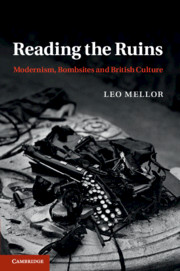Chapter 4 - The haunted city
Published online by Cambridge University Press: 07 October 2011
Summary
‘No,’ she said, ‘stay. Please.’
‘Why?’
‘You are safe here.’
He smiled. ‘From more bombs?’
‘From a lot of things.’
Graham Greene, The Ministry of Fear (1943)
The pre-First World War vantage point of H. G. Wells’ The War in the Air (1908) extended as far as imagining beyond the cataclysm of bombs and zeppelins. For at the end of this work ghosts populate the futuristic bombed city; ghosts that could be animated out of the ruins.
They say there’s a ’og man in Beck’n’am what was lost in London three days and three nights. ’E went up after whiskey to Cheapside, and lorst ’is way among the ruins and wandered. Three days and three nights ’e wandered … then a lot of whistling, shrill whistles, whistles that froze ’is marrer. And directly the whistles began things begun to show, people in the streets ’urrying, people in the ’ouses and shops busying themselves, moty cars in the streets, a sort of moonlight in all the lamps and winders. People, I say, Teddy, but they wasn’t people. They was the ghosts of them that was overtook, the ghosts of them that used to crowd those streets.
The actuality of the bombing of London was not quite so severe as to create a terrain that would allow a swineherd such an adventure; but after the Blitz the city, unhoused, on edge and shattered, was one amenable to numerous forms of strange sensations – and depictions. The possibility of the phantasmagoric in a ruptured cityscape, which was unexplainable with conventional logic or undepictable according to available materialist systems of plausibility, seemed to many writers a natural assumption. This was especially the case when the shape-shifting actuality of destruction seemed to literalise and release images that were previously purely hidden in mental depth; making the unconscious conscious. For the bombsites as a terrain not only disclose a history, in as much as they expose layers of the past, and of quotidian lives, but they also become ruins unlike any ever seen before. They are thus both old and new, linked both to the past and to immediate human pain and suffering; they become places of phantasmal apparitions. The major writers to be attended to in this chapter – Graham Greene, Elizabeth Bowen and David Jones – all use these possibilities, but they do so in divergent ways and offer different complex moral inheritances.
- Type
- Chapter
- Information
- Reading the RuinsModernism, Bombsites and British Culture, pp. 138 - 165Publisher: Cambridge University PressPrint publication year: 2011



